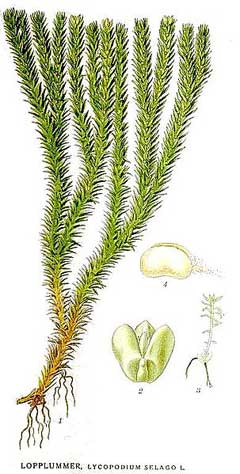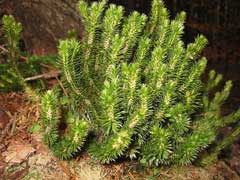 |
|
http://commons.wikimedia.org/wiki/File:516_Lycopodium_selago.jpg |
 |
| http://commons.wikimedia.org/wiki/User:Tigerente |
Translate this page:
Summary
Physical Characteristics

 Lycopodium selago is a FERN growing to 0.3 m (1ft).
Lycopodium selago is a FERN growing to 0.3 m (1ft).
See above for USDA hardiness. It is hardy to UK zone 2.
Suitable for: light (sandy) and medium (loamy) soils, prefers well-drained soil and can grow in nutritionally poor soil. Suitable pH: mildly acid, neutral and basic (mildly alkaline) soils. It can grow in full shade (deep woodland) or semi-shade (light woodland). It prefers moist soil.
UK Hardiness Map
US Hardiness Map
Synonyms
Plant Habitats
Woodland Garden Dappled Shade; Shady Edge; not Deep Shade;
Edible Uses
Edible Parts: Leaves
Edible Uses:
The plant is edible[161, 177]. Caution is advised, see the notes above on toxicity.
References More on Edible Uses
Medicinal Uses
Plants For A Future can not take any responsibility for any adverse effects from the use of plants. Always seek advice from a professional before using a plant medicinally.
Analgesic Emetic Homeopathy Hypnotic Purgative
The plant is hypnotic[192]. Chewing three stems is said to induce mild intoxication whilst eight can cause unconsciousness[192, 213]. The plant has been used as a fast-acting emetic and purgative[257]. A poultice of the whole plant has been applied to the head in the treatment of headaches[257]. A homeopathic remedy is made from the whole plant, collected during the summer[9]. It is used as a laxative and to kill worms[9].
References More on Medicinal Uses
The Bookshop: Edible Plant Books
Our Latest books on Perennial Plants For Food Forests and Permaculture Gardens in paperback or digital formats.

Edible Tropical Plants
Food Forest Plants for Hotter Conditions: 250+ Plants For Tropical Food Forests & Permaculture Gardens.
More

Edible Temperate Plants
Plants for Your Food Forest: 500 Plants for Temperate Food Forests & Permaculture Gardens.
More

More Books
PFAF have eight books available in paperback and digital formats. Browse the shop for more information.
Shop Now
Other Uses
Mordant
The plant can be used as a mordant in dyeing[172].
Special Uses
References More on Other Uses
Cultivation details
Thrives in a rough spongy peat in a shady position[1]. Requires a humid atmosphere[200]. Terrestrial members of this genus are hard to establish. The roots are delicate and liable to rot, most water being absorbed through the foliage[200]. Members of this genus are rarely if ever troubled by browsing deer[233]. Although looking more like a moss, this genus is closely related to the ferns[200].
References Carbon Farming Information and Carbon Sequestration Information
Temperature Converter
Type a value in the Celsius field to convert the value to Fahrenheit:
Fahrenheit:
The PFAF Bookshop
Plants For A Future have a number of books available in paperback and digital form. Book titles include Edible Plants, Edible Perennials, Edible Trees,Edible Shrubs, Woodland Gardening, and Temperate Food Forest Plants. Our new book is Food Forest Plants For Hotter Conditions (Tropical and Sub-Tropical).
Shop Now
Plant Propagation
Spores - best sown as soon as they are ripe on the surface of a humus-rich sterilized soil. Keep the compost moist, preferably by putting a plastic bag over the pot. Pot on small clumps of plantlets as soon as they are large enough to handle and keep humid until they are well established. Do not plant outside until the ferns are at least 2 years old and then only in a very well sheltered position. The spores are generally produced in abundance but are difficult to grow successfully[200]. The spores of this species are not functional, the plant reproduces only by gemmae[17]. Layering of growing tips[200].
Other Names
If available other names are mentioned here
Native Range
TEMPERATE ASIA: Japan NORTHERN AMERICA: Canada (Northwest Territories, Yukon, Québec, Nova Scotia, Ontario, Prince Edward Island, New Brunswick, Newfoundland and Labrador, Saskatchewan, Alberta, Manitoba, British Columbia), United States (Connecticut, Maine, Massachusetts, Michigan, New Hampshire, New York, Ohio, Vermont, Minnesota, Wisconsin) EUROPE: Denmark, Finland, United Kingdom, Iceland, Norway, Austria, Belgium, Switzerland, Germany, Poland, Lithuania, Russian Federation (Karelia, Neneckij avtonomnyj okrug), Greece, Spain
Weed Potential
Right plant wrong place. We are currently updating this section.
Please note that a plant may be invasive in one area but may not in your area so it's worth checking.
Conservation Status
IUCN Red List of Threatened Plants Status :

Growth: S = slow M = medium F = fast. Soil: L = light (sandy) M = medium H = heavy (clay). pH: A = acid N = neutral B = basic (alkaline). Shade: F = full shade S = semi-shade N = no shade. Moisture: D = dry M = Moist We = wet Wa = water.
Now available:
Food Forest Plants for Mediterranean Conditions
350+ Perennial Plants For Mediterranean and Drier Food Forests and Permaculture Gardens.
[Paperback and eBook]
This is the third in Plants For A Future's series of plant guides for food forests tailored to
specific climate zones. Following volumes on temperate and tropical ecosystems, this book focuses
on species suited to Mediterranean conditions—regions with hot, dry summers and cool, wet winters,
often facing the added challenge of climate change.
Read More
Expert comment
Author
L.
Botanical References
17200
Links / References
For a list of references used on this page please go here
Readers comment
| Add a comment |
|
If you have important information about this plant that may help other users please add a comment or link below. Only comments or links that are felt to be directly relevant to a plant will be included. If you think a comment/link or information contained on this page is inaccurate or misleading we would welcome your feedback at [email protected]. If you have questions about a plant please use the Forum on this website as we do not have the resources to answer questions ourselves.
* Please note: the comments by website users are not necessarily those held by PFAF and may give misleading or inaccurate information.
To leave a comment please Register or login here All comments need to be approved so will not appear immediately.
|
Subject : Lycopodium selago
|
|
|
|